
Joe's Stories from the Road
for the month of April 05
April 7, 2005
Looking Forward, Looking Back
January 6, 1967, I was discharged from the US
Air Force. My childhood friend, Wilson Crabtree, and I had joined
together in 1963. It was getting time to reenlist or get out and we
were talking often by phone. I told Wilson that they had had four years
to send me to Vietnam
and didn't but I knew that is where I was headed if I reenlisted.
Wilson said he had started
a family and there were no good job s back home so he was going to
re-up. He did and within six months he was in the middle of a war
that was not popular with the folks back in America. Wilson wanted to
know what I was going to do.
A few months after I got to my USAF assignment
at Vandenberg Air Force Base I picked up a new book by John
Steinbeck, titled, Travels With Charley. It was an adventure where
Steinbeck took his big French Poodle, Charlie, and traveled over
10,000 miles throughout America in a hand fashioned camper
named Rocinante. I dreamed about someday seeing America that way. Couldn't afford a
camper burning that much gasoline but I could ride a bicycle and
have a long and wonderful visit with
America
as Steinbeck did. So I told my childhood friend Wilson that I was
going to discover America
by riding a bicycle 14,000 miles throughout
America. Wilson, known
for not wasting words said, "Good luck."
I put the bicycle and the necessary gear in
storage and bought a Greyhound bus ticket for $99.00. It would let
me travel by greyhound anywhere they went for 99 days. To pass the
time waiting for the snow to stop flying I boarded the greyhound in
Santa Maria, California, and traveled about
12,000 miles. I got an idea of what would be required of me to do a
14,000 mile odyssey on a bicycle.
The greyhound delivered me back to Santa Maria about three months later. With the
bicycle out of storage some friends took me to Ocean and H Streets
in Lompoc, CA. A German friend and bicycler met me there. At 9:00 a.m. on April 8,
1967, I mounted my fully packed Schwinn Supersport bicycle and rode
off into one of my greatest adventures of all times. That bicycle,
with my worn shoes and several items that people gave me along the
way, have graced a section in the Red River Museum in Clay City, Kentucky, for nearly
four decades. In a little more than a year I will loan the museum
another bicycle. Its name is Rocinante.
Driving across America in early April of this year
it began setting into my mind what I was about to do.
I was going to get to Re Discover America
on a bicycle. That was exciting. But as I traveled along in long
miles of silence with my sweetheart, Barbara Crabtree, I began to
think about how much I was going to miss her and my eight beautiful
grandchildren. But I have to do the bicycle trip. I knew I had to do
it again someday.
On April 8, 2005 at 9:00 a.m. at Ocean and H in
Lompoc, California, I threw my right leg over my Trek steed named Rocinante, grabbed the
reins, I mean handlebars, and rode off to the next greatest
adventure of a lifetime.
April 13
My First Letter on a Computer
This is the first message I have ever written
on a computer. I have answered e-mails but I’m composing this
tonight and will send it tomorrow. This is a first. Cliff is putting
me through computer school. He is an incredible man. He is patient
with me so I’m going to learn this. He is also an artist around
people. They are drawn to him like flies to a ripe piece of
watermelon.
The Ride Joe Ride trip is grander than I ever
imagined. Gene Stevens, the gentleman who put together the sendoff
at Lompoc, worked for the Lompoc Recorder in 1967
and was the person who wrote the first story about the first trip.
We stayed with Bill and Gladys Paulsen who I stayed with in 1967 on
the first night.
We were stopped on the road the second day and
invited to dinner that night.
In 1967, the only time I remember seeing a
bicycle rider was when two teenage boys rode with me between Bonners
Ferry and Sandpoint, Idaho,
with their parent’s permission.
The parents came out on the road and asked if it was okay. Of
course I saw children riding in their neighborhoods. This time there
is a huge difference. The first day we saw 5 serious cyclists. The
second day we saw 38. And today we saw 15 cyclists. That is cool
because they always wave and acknowledge you.
And there are other things that are different.
The last time it was just me. It was very hard leaving Barbara this
time. And I am missing 8 beautiful and awesome grandchildren. Wow,
man that is rough! Friends are more important to a 62-year-old man than they are to a
23-year-old. And the
communication difference is unbelievable. In 1967 I would write home
to mom and tell her to write a general delivery letter to a small
post office maybe 300 miles ahead of me. I would instruct her to
write on the bottom of the envelope, “Hold for 30 days.” When I got
to that little town I would pick up my mail. I always used small
towns because in large towns it would be hard to locate the post
office. And now look at how I am doing it! I write, then punch a few
buttons and not only does one person back home get the message, but
people around the globe can read it.
What did I do about photographs in 1967? We’ll,
on a lot of occasions I would be interviewed by newspaper reporters
because what I was doing was so rare. I would agree to an interview
if they would send a copy of the clipping and a photo to my mother.
I carried a good camera but was very limited to how much film I
could afford. I took slides because photos were too expensive. I
only shot four rolls of film during the entire trip.
And now in four days I have shot 73 photos,
downloaded them to my computer, looked at them and did some editing
and tomorrow will send five or six home to Appalachian Heritage
Alliance. The sending only takes a second. When I get home to
Kentucky in about a year I can do more editing, cropping, enhancing and then
just print onto paper the ones that I want. At any time I want
during the trip, or after, I can look at them.
Better go for now.
My best to everyone.
Sincerely, Joe

April 14
Rugby?
This computer business is fun. Cliff is an
awesome teacher. I've unloaded photos into my computer twice. I
unloaded a letter to disc then put it in Cliff's computer and sent
it to Kentucky.
Yesterday, I got to do something I've never
been able to do. We rode to Salinas
to visit the John Steinbeck Center. That was great but
I'll get back to that. On our way back into Monterey there is a downhill about five miles
long with a six foot wide bike lane. The cars had started stacking
up because of drive time home. I began passing cars that were going
eight miles an hour. I was traveling 25 to 30 miles per hour. Passed
over four miles of cars. Two, at different times, tried to block the
bike lane so I couldn't pass them. One got into the bike lane and I
almost had to take the ditch to pass him- and would have if he
hadn't given me a few inches at the last minute.
At the Steinbeck Center the people were
great. They let me take my Rocinante into the museum and have me, my
Rocinante and Steinbeck's Rocinante all get photographed together.
It was a great experience to be there with that camper that
Steinbeck talked so much about in “Travels with Charlie.” That book
inspired the first 14,000-mile bicycle trip.
Today, we
bicycled over 50 miles and most of it was on a bikeway out in the
country away from cars. It even had a painted middle line. Met a lot
of traveling bicyclists. We see 25 to 50 each day. So very much
different from 38 years ago. Then, there were no bicycles out but
mine. Today we came through the Artichoke Capitol of world. We also
rode by thousands of acres of strawberry fields. Took photos for the
kids of the people picking them.
Special apology-
"Joe Bowen is very regretful that he has misinformed Ken Thompson
for many years about the Artichoke Capitol of World. It is not
Watsonville. The Capitol is actually Castorville, Calif."
In the evening we checked into a hotel
in downtown Santa Cruz. At the pool we
met a group of young men who had worked hard and were in the Elite
Eight in college Rugby. They were
the team from Florida State University.
They made a big deal of Cliff and me on the bicycles. We had photo
taken with the entire team and they signed our book. They thought
Cliff and I were cool. In fact, Cliff and I have been pleasantly
surprised by the very positive response from the young people. They
want to hang around and talk about what we are doing.
Better go. My best to everyone.
This is the end of the first week.

April 15
A Camper, a Half Moon, and a Sunk Pigeon
The visit at the John Steinbeck Center was great. We were treated really well by the folks that run it. One
thing I forgot to mention was how they acquired the camper,
Rocinante. A farmer in New Jersey had bought it at auction. He took
it home and used the pickup on his farm for several years. When the
center learned that he had it, they asked how much he wanted for it.
He told them he would give it to them and that the old camper was up
in the barn and they could have it, too. It was almost like
original. Mrs. Steinbeck had sewn the curtains and they were still
in the camper. I have photos from inside the center with me and my
Rocinante standing beside his Rocinante. (editors note- The
reason why Steinbeck and Joe chose the name “Rocinante” will be a
question for the students.)
Today finds us in Half Moon Bay,
about 30 miles south of San Francisco. We bicycled completely around the
Monterey Bay. The students can see
on a map how it is shaped.
On a bicycle it took all day to come from
Santa Cruz to here, 48.6 miles. Yesterday we
pedaled around the south side of the bay which took all day and
covered 51.6 miles. Compare Monterey Bay to a similar sized map of
Kentucky and you can see how big is.
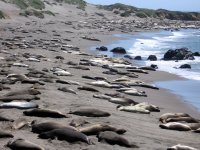
Sunbathing Sea Lions
A highlight of
today was pedaling on a large coastal plain. The hills and cliffs
were not as definite. Pedaling north around the bay I could see far
in the distance a building and a tower.
Couldn't make out exactly what it was but as I got closer it
turned out to be a lighthouse. I took photos as I approached, beginning about five miles
down the coast. When close I could see the jagged rock cliffs under it and the breakers
coming in from the ocean.
I rode down the point for a better look and better photos.
It is called the Pigeon Point Lighthouse.
It is the tallest lighthouse on the Pacific Coast of North
America- 115 feet tall.
In June, 1853, a
Boston based ship, Carrier Pigeon, on her maiden voyage, was torn
apart by a fog blanketed rock off what was then called Whale Point.
But after the Carrier Pigeon sank, its name changed to Pigeon
Point. Several
shipwrecks in the 1800s indicated a need for a lighthouse.
So, on November 15, 1872, the station's fog signal began
sounding a distinctive bellow that guided mariners for more than a
century. The original
lens that magnified the light in the beginning was 16 feet tall and
weighed 4 tons. Now, it
is operated by modern lighting technology.
Thank you David and Janine for helping me work
through this. We are
doing a great work for our Eastern Kentucky and the rest of the
state. I guess I will
be learning during the whole trip. Cliff is answering your email
while I get this off to you.
Sincerely, Joe
Bowen
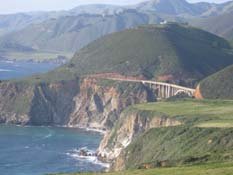
April 18
Now and Then
I know America is different now than what
it was in 1967 and 68. I
find myself looking around the next curve to see if I remember what
will be there and or how it is going to be different.
Cliff and I rode up the coast from Half Moon Bay.
Things are kinda the same as I remembered except I had ridden
through some rainy days by now in 67.
This time the sun has been generous to us even though the
north winds have pounded us right in the face almost every day.
I told Cliff, "Hey buddy.
When we get in the area of the city of Pacifica
we are going to encounter some of the hardest climbs on the trip.”
We didn't hit the really steep ones until we were north of
Pacifica but we surely hit them.
Straight up. Just as I
remembered. There were
homes only a few feet apart hugging the side of the mountains as we
climbed the streets. Straight up. It was time
to dismount and lead Rocinante up the inclines.
An hour or two of this and we were
leveling out on Skyline
Drive, San Francisco. Still, thousands of homes.
I asked a man on the street what the going price for a home
in the neighborhood was.
His answer, "five hundred thousand".
The homes would have sold for maybe $80,000 in Kentucky.
And we would never think of putting one on a mountain like
that. If you can imagine
homes fifteen feet apart going up the hill to Cabin Country at
Slade, on both sides of the road, that is a large part of San Francisco.
I'm rambling. Sorry. Back to
things being different. In 1967, as I approached Golden Gate Park in San Francisco I noticed a lot of cars parked
at random on the side of the road.
Once in the park, cars, trucks and a lot of Volkswagen busses
were parked everywhere.
Thousands of people were walking around.
Remember, Hans, my cycling friend, and I had just gotten out
of the Air Force. I had
short trimmed hair and no beard.
Wore clean, neat shorts and tee shirt.
These men and women milling around in the Park and seeming to
be going somewhere were dressed in baggy clothes, tee shirts with
colorful markings, wearing sandals and the men sported long hair and
beards. We had ridden
into one of the largest Vietnam War demonstrations of the era.
Maybe 200,000 people were gathered.
We followed them to Kazaar Stadium.
At the time I had begun to have my doubts about whether we
should be in Vietnam. But I had not realized that America was so
angry about the war. We
listened to Coretta King and Robert Vaughn speak. Then we pedaled
out of Golden Gate Park. Oh yes. Even the name of
the stadium has been changed.
Now, 2005, I ride into Golden Gate Park.
It is much different. Again, thousands of people. It’s a Saturday,
as before. This time, the people are happier. They are playing with
their children. They are throwing frisbies. There are the skaters.
There are tour busses loaded with old folks like me. Boy, that tour
bus just does not get if for me. Maybe someday. There are thousands
of bicyclists- everywhere. And the auto drivers are sharing the
streets with the cyclists. I am amazed. At intersections, car
drivers more than once stopped and motioned for me to go first. All
in all, a very pleasant scene. In 1967 and 68, the country was very
angry about the Vietnam War and the race problems. As a country, we
wanted both problems to go away.
I love butterflies. Somehow
butterflies carry some sort of magic for me. I won't get into that.
Just understand that butterflies are important to me. Down on the
coast at Big Sur I had my first messenger. Pedaling along at about 15 mph as the sun
and the darting shadows of the redwoods played with me, I looked up
and noticed a beautiful Monarch gliding down the highway with me. I
had never realized that one of these wonderful creatures could
travel so effortlessly at 15 mph. He stayed with me for over a
hundred yards to let me know all was well and that I was doing the
right thing and going in the right direction. Even if it was against
the wind.
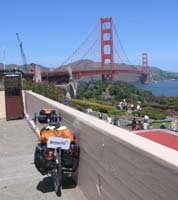
April 20
Golden Gate
Back in
San Francisco. I'm anxious. I'm excited-
waiting for that first view.
That magic moment when you see it. The magnificent
Golden Gate Bridge!
Seeing it for the first time or seeing it again after 38 years is
exciting. And suddenly there it was in front of me- spanning the
entrance to San Francisco Bay. I don't remember pulling the brakes
on but Rocinante stopped in his tracks. I took a deep breath and I
know there was a smile on my face. I consciously thanked our God for
letting me do this one more time. Twice in one lifetime. Wow!!!!
To the world, the Golden Gate Bridge is the gateway to the
San Francisco Bay. The Golden Gate Bridge,
to Joe Bowen riding his gallant steed, Rocinante, was and is the
gateway into America. To me,
it was different in 1967 than it is today in 2005. The trip up the
coast fighting a 25 mph direct headwind, rain on the first day, the
unforgiving mountain climbs and descents on the rugged coast were
just a test to see if I was worthy to be permitted to do this again.
I know I had passed the test.
Cliff sprung for a stay at the Courtyard on the
Fisherman’s Warf. After a ride on the San Francisco Cable Cars we
spent the whole evening eating dinner with Cliff's daughter, Sally,
and her friend, Chris. We talked about Kentucky, Wolfe County,
and what they were doing with their lives. Chris is a meteorologist
and a brilliant young man. Sally is soon to have her PhD from Berkley. I believe we will be hearing more
about Sally in the near future because of her very important finds
in her world of scientific research.
About the Cable Cars. All my life I had assumed
that the cable car just took you to the top of the mountain that
San Francisco is built on and back down. Not
so. It is a network of underground cables that pull the cars to many
different parts of the City on The Hill. The brochures and the ads
in the travel magazines don't tell the whole story.
I couldn't sleep that night thinking about the
crossing. In 1967, Hans and I rode up to the Gate with our bicycles
and stopped at the coin-operated turnstile to gain entrance. Hans,
going first, walked through the turnstile while carrying his bike
over his head. I followed, put a dime in the slot and pushed my
bicycle through the revolving chrome arms. One coin was not enough.
Half way through, the arm stopped moving. The bicycle was stuck. I
walked back to the gatekeeper and got more change. He reminded me
again, "Do not ride the bicycles once you are on the walkway across
the bridge". I assured him that I understood.
One more dime and the bicycle was free. We pushed the
bicycles out a quarter mile, mounted them and rode across in
defiance of that authority we had left at bridge's entrance.
Had things changed gradually over 38 years or
had it changed overnight? From where I was it seemed overnight but I
knew better. Morning came. After breakfast with Sally and Chris we
mounted up. I couldn't wait. In the distance I could see the great
maroon span of steel, cables and concrete. Just under the bridge we
climbed the 100 plus feet to the floor of the gateway. Pretty much
alone in 1967 but not on this sunny Sunday. Thousands of people were
casually walking the gateway. The walkways on both the ocean and the
bay side of the bridge were open. No turnstiles, either. Between the
walkways are ten thousand cars and trucks traveling 45 mph on six
lanes. And the greatest change of all was sharing the
Golden Gate with thousands of bicyclists. Half mile out
on the two and half mile long bridge I pulled Rocinante up for some
photos.
Then on again. I was in awe of the towering
steel towers that held the bridge up. Shortly after passing the North Towers,
the Monarch appeared again. This time, in a gentle breeze from the
Pacific. He only stayed a minute but I got his message. Everything
was okay.
God bless all of you and thank you for being
interested in this project of Rediscovering Bicycle
America and later the educational
aspect for our children and grandchildren.
Sincerely, Joe Bowen
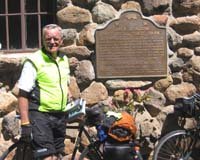
Jack London Museum
April 22
The Call of the Wild
Last night I
learned a valuable and painful computer lesson.
I spent two hours, until one o’clock in the morning, writing
my narrative. I read it
over then e-mailed it. And there it disappeared into who knows where.
My buddy Cliff tried to find it but it was gone.
I was sick. I
had worked two hours on it. Always save your work.
There are people
back home that I miss. I think about Barbara a lot and get sad.
Then I talk to her at night and it gets better.
And my grandchildren? That’s a rough one, too.
My grandson Caleb sent me an e-mail and told me how he and
Caden missed me and how much they loved me.
I miss them, too. I also miss Ross, Kyle, Shelby, Avery, Annelle and Yusef.
I miss my church family at The Bowen First Church of God,
too. They are good
people and I know they love me.
Cliff and I left
the Golden Gate and coasted our way down into Sausalito, the town on
the north bay looking at the city on the hill, San Francisco.
We stopped at a little Italian Cafe with outside tables.
The sun was bright- perfect for outside dining.
I started counting bicycles that pass our table.
In about an hour over 160 bicycles passed.
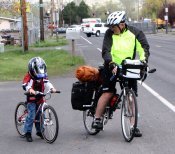
"Hey, Buddy, Wanna race?"
In 1967, once we
got out of Sausalito, we were pretty much out in the country on our
way north. Not this time. It was all city
for 30 miles.And there was another maze of bikeways to navigate.
We would ride a few blocks and would have to ask a cyclist
which way to turn. The bikeways went in every direction.
After about three hours we were out in the country again and
on our way to Petaluma.
It is a beautiful little town of pretty old homes.
All very well kept.
Outside of Petaluma
the next morning, it happened again.
It’s becoming ordinary. An older gentleman rode up to us
while we were looking at our map.
Wanted to know what we were doing and then told us he sure
would like to be traveling with us.
A lot of people dream of the ultimate adventure.
It seems these days that the bicycle is the way to go.
I remember in 67 people would come up to me and tell me about
the adventure they had planned but never got around to doing.
And then, at middle age, they regret that they had not done
it. For me, I did it
then and now get to do it again.
We spent the day
cycling past thousand of acres of grape vineyards.
The old mature stumps of the grapes, about four feet tall
with green new growth on top, stand in long rows.
As far as you can see there are rows. They reminded me of the
white crosses in a military cemetery. Onward and around a mountain and
we were in the Sonoma
Valley. Next would be
the Napa Valley. This
is the place on earth that grows the sweetest grapes.
It is so because nowhere on earth do
the grapes get that much warm sunshine. That puts the
sweetness in the grape.
Before Napa,
though, I had a visit I had to make.
Up the valley was Glen Ellen.
Just a small village.
A mile up a steep grade out of Glen Ellen was the home of
Jack London. I had
visited before but it was a must-see again.
As a little boy on the farm at Bowen I read the Jack London
adventure books and dreamed of when I could go on my own adventure.
My favorite was “The Call of The Wild.”
I sent copies to my grandsons hoping they would read what I
read long ago.
Once up the climb, I visited London’s home.
The lady caring for the place let me take Rocinante inside.
We had our photograph taken in London’s living room.
That Rocinante sure is a privileged character.
Being there, I was reminded of something that London had
written that I adopted as my own when I was a boy.
Maybe still do.
“I WOULD RATHER BE ASHES THAN DUST. I WOULD RATHER THAT MY SPARK SHOULD BURN OUT IN A BRILLIANT BLAZE THAN IT SHOULD BE STIFLED BY DRYROT. I WOULD RATHER BE A SUPERB METEOR, EVERY ATOM OF ME IN MAGNIFICENT GLOW, THAN A SLEEPY AND PERMANENT PLANET. THE PROPER FUNCTION OF MAN IS TO LIVE, NOT TO EXIST. I SHALL NOT WASTE MY DAYS IN TRYING TO PROLONG THEM. I SHALL USE MY TIME.”
London was a world famous writer by the time he was 27 years old and he died when he was forty. He had been raised in poverty in San Francisco. During his short life he wrote over 50 books and hundreds of magazine and newspaper articles.

April 24
Helpers, Guides and Angels.
In Napa, Cliff was having some serious problems
with his bicycle so we stopped in a bicycle shop. It was closing
time. Nevertheless, the young man in charge told us to come on in
and that he would take care of us. Scott Rose was his name. He took
Cliff’s bicycle to the back and hosted it up on a rack and clamped
it on. Once in place, he proceeded to take the crank off and turned
a sprocket ring around that had been put on backwards. Then he
dropped the back wheel off and straightened it. I watched in
amazement. The young man did not have a left arm. He told me he had
lost it at birth to cancer. If you are ever in Napa and need emergency
medical assistance he would be the one to help you. His real job is
an EMS on an ambulance and he is in school to become a nurse.
Outside of Napa
the next morning we met another of our serendipitous helpers, or
guides. Kinda like an angel when you need one. Like the bike shop
mechanic. It was time for our first test. The mountain starring at
us was a three-mile climb from 100 feet elevation to over 1200. Most
of the climb 8% grade or better. I pulled the entire mountain in one
take. It was time to find out if I could do it because soon I would
be in the High Sierras. At the top I stopped to rest, catch my
breath, and write in my journal. A gentleman walked over to the rock
I was setting on and asked what I was doing. After we talked a few
minutes he walked back to his house and came back with bananas, home
made cookies and Gatorade. He told me he had moved to that mountain,
Mount George, an ancient
volcano, in 1949. He had come there from
Louisville, Kentucky. He was Ernie Bean. A
great guy.
Over two more mountain passes and we were at a
power dam that I had been looking forward to seeing again because it
had an odd spillway. The spillway was a hole out in the lake that
was about 30 feet round and the water spilled over into it. Once
there, I couldn’t find the spillway. I looked in every direction.
Cliff laughed at me and then I spotted it. Two dam workers
saw my excitement and chimed in with Cliff. But they were generous
enough to open the gates and let us go out on the dam so we could
take better photos.
Soon we were on the Sacramento Valley
floor going across the flat country at 22 mph. After we navigated
through Davis we arrived at
crossing that was not allowed by bicycle in 67. In
Davis, at the University of California- Davis,
another guide shows up. We stopped a young man on a bicycle and
asked how to get to the causeway bikepath to
Sacramento. “Follow me and I will take you,"
he instructed. We fell in behind and he took us in many directions
through the bicycle maze of Davis. There were stop signs, directions, and
even speed limits for the bicyclists. Across town and we are on a
bikeway looking far into the distance at
Sacramento. The young man, Kien, stayed with
us for another five miles and then led us up an incline to the
causeway.
“This is it, fellows.” We said our goodbyes,
exchanged e-mails and snail mail addresses and he turned back toward
Davis. We were on our way to Sacramento. The causeway is a concrete bikeway
on concrete piers just like the car highway that crosses the swamps
and wetlands on the west of Sacramento. Soon we were photographing
ourselves with the State Capitol in the background. Then, 14 more
miles through city streets to East Sacramento
to my friend's home and horse ranch.
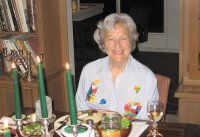
They are the Lloyd and Beth Henning family.
They had kinda adopted me when I was stationed at Vandenburg Air
Force base in the early 60s. Colonel Henning offered to pay for my
college education upon discharge from the Air Force but I had to do
the bicycle trip. A few years ago I visited and the Colonel hugged
me and told me he was just as proud of me the way it was even if I
didn’t take him up on his offer. The family chose not to tell me
until I got there that the Colonel died while I was on the “Across
Kentucky Warm-up” bicycle ride this winter. He was a good man and
I’ll miss him.
Thanks for checking out our web site. Don’t
forget to check out the monument project.
Sincerely,
Joe Bowen
April 27
Smells, Plants, and Mountains
The last two days we’ve been going into the
High Sierras. During this climbing we’ve been seeing a lot of
eighteen wheelers with monstrous loads of bailed hay in the small
rectangle bails. And there have been a lot of tractor and trailer
loads of fresh sawed lumber. When they pass, the sweet smell of hay
and the pine lumber hangs in the air for a few minutes after they
have gone on down the highway. I wanted to talk to you about this
because in a car or truck you very seldom experience the smells of
the road unless it is a skunk. On a bicycle you always know. You
know when an animal has been killed nearby by car or otherwise long
before you see the animal. You know by smell when it is going to
rain in the area. You can smell it. And when it starts to sprinkle
on a warm asphalt highway there is a different smell for that too.
Riding by a newly mowed hay field provides a
different aroma than the trucks hauling the bails of hay. There is
also a big difference in the smell of cattle near a barn versus
those grazing in a field. And a hog operation, well, you just wished
you hadn’t ridden down that road. On this trip the best was when we
were riding down the highway with thousands of acres of strawberries
on both sides of the road. That is such a wonderful sweet delicious
smell.
So how about the plant life in California? Much of is very different than in
our Kentucky.
Then there are the plants that are the same but not really the same.
There are sycamore trees. Ours grow taller than theirs and
the oak is an oak but totally different than ours. And the California redbuds are in
bloom now and they look a little different. The dogwoods in the
forest are definitely different. But listen to this. The poke is exactly like our poke in Kentucky. I’ve seen a lot lately and it is
perfect for picking. If Barbara was with us we would have already
had several messes of that delicious green. Cooked tender with a
little bacon grease over them and a generous sprinkling of apple
vinegar. I wish I had had some for supper tonight.
We have the beautiful
Eastern Kentucky
mountains but we don’t have anything that can come close to the High
Sierras. I wish I could take every child in
Eastern Kentucky
to the Sierras. Since before arriving in
Sacramento, we’ve been watching the High
Sierras. When we first saw them they were probably 50 miles away.
They are all blanketed in snow now. Later in the year most of the
snow will be gone but some will be there always. The last two days
we’ve been watching a special show. Coming into view from behind the
near foothills we catch a quick look at Mount
Shasta. Then, after two or three minutes it has
disappeared. Not very noticeable from 50 miles away but you know it
is Shasta. Then we start
the climb and don’t see it for hours. The foothills have hidden it
from us. Maybe we won’t see it again. We climb and climb. One
thousand feet, then two, and then three. Near four thousand feet and
still climbing at five miles an hour when suddenly through an
opening in the pine trees this magnificent mountain appears,
towering above all others.
It is much taller than any of the mountains around it and it
is solid snow. Most of the mountains are snow capped but you can see
rock or part of the mountain itself. Not with Shasta. It is all snow
but you can see its shape by the shadows of the jagged cliffs in the
snow. I had to stop many times all afternoon to take photos hoping I
would get the perfect picture. I was never satisfied that I had
captured what I had seen. That’s why I would like our children see
these mountains. To see them is the only way you could understand
how grand they are.
And speaking of the mountains. High across the
top of a public building in
Sacramento
there is written in the stone these words, “SEND ME MEN TO MATCH MY
MOUNTAINS.”
Leaving Sacramento
was a little sad. It is always hard to leave family and good
friends. And the Hennings feel like both. It was the same saying
goodbye to Bill and Gladys Paulsen. When we left, Heather, the
eighteen-year-old granddaughter and daughter, went on her bicycle
with us. She is an excellent bicyclist and it was her first 33-mile
ride. And most of it was done in the rain.
Then we had to say our goodbyes again.
And now we are in the mountains and I can still
pull an enormous climb. Now I’m confident that I will be able to
manage the Cascades in Washington and the Rockies from Canada to Mexico. I did it many times when I
was 23. I crossed the Continental Divide 13 times in the summer of
67. Thirty-eight years makes a lot of difference but I can still do
it. I HOPE.
April 29
Into Oregon
It is Friday morning and I’m waiting on
Barbara’s brother Pete and his two teenage boys to get here. I’m in
Klamath Falls, Oregon.
I crossed my first state line yesterday afternoon. Pete lives about
70 miles from here. I’m looking forward to visiting with him and his
boys.
Yesterday I got a pleasant surprise. My sixth
grade teacher, Kathryn Cox, at
Bowen Elementary School in 1956
wrote me an e-mail. Now that is cool.
I hope she won’t be too critical of my spelling and grammar.
Several days back I was talking about missing
the people that I love back home. I talked about Barbara and my
grandchildren. Well, I got a call from one of my daughters and was
asked, “And you don’t miss your daughters?” I could tell that she
enjoyed harassing me. I miss all of my daughters, Shawna, Lonna, and
Natalie. I also miss Beck, Parnell, David, Paul, Will and Connie.
Now it is a day later and I am still in Klamath Falls, Oregon.
Pete and his boys, Paden and Dalton
came by and spent most of the day with us. The boys went with me to
do our laundry. That has to be done out here, too. Cliff had to do
some work so it gave me more time to visit with Barbara’s brother.
The whole family are fishermen and hunters and they live in a good
place for people that have a passion for those sports. It was cool
being called Uncle Joe up here in Oregon. Paden and Dalton, you both are special young men and I
know good things are in your future.
Dalton, when that woman dropped her goods at
WalMart and you ran over and picked them up for her you impressed me
a lot. I told Cliff about it and he talked all afternoon of how
polite and gentlemenly you both are.
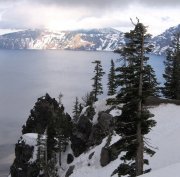
Our plans were to leave Klamath this afternoon and get in a few miles toward Crater Lake. We talked to the lady at the hotel about our plans of riding the bicycles there and then on to Roseburg. She told us we couldn’t ride that way because the highway was closed. So, change of plans. We rented a car and drove the 60 miles to Crater Lake. I knew it was an important stop for the school children so I took a lot of pictures. Crater Lake is kinda like Grand Canyon. It is so spectacular that you can look at a thousand photos but you cannot understand how grand it is until you are standing there with it face to face. Once there we understood why we could not go through with our bicycles. The highway on through has 81 inches of snow on it. We have decided on another route that will take us to the east of the mountains and then through a pass going into Eugene, Oregon.
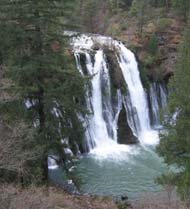
A few days back we visited the
Burney Water Falls and then came across
our third or fourth mountain pass. Released the brakes and headed
downhill for about four miles into the little western town of Fall River Mills. Got a room and went down to
the Fall River Hotel which is being restored. Luckily, the café was
open. They served us a wild rice salad that was out of this world.
Most delicious. I got their recipe and maybe, with the encouragement
of Ken Thompson, will put together a 14,000-mile bicycle trip
cookbook of all the best foods I ate on the trip.
And that reminds me about all the incredible
people in my life that are important to me that I won’t get to see
for year. Some of them live in
Powell County and Spencer County, Kentucky. I
may even be able to find a real good recipe at the TEA CUP in
Taylorsville. I’ve eaten some good food there and will
stop in for another meal on my way through on this trip. Hey Bob and
Pete I love Dairy Queen, too. That’s a good place to find out what
is happening in Taylorsville and Stanton, Kentucky.
The day after Fall River Mills we had ridden a
good morning and stopped in Bieber for lunch. Bieber is in a valley
about ten miles wide between two mountain ranges. Out of the
restaurant we could here thunder coming from the direction we were
headed. In the east the sky was almost black. I had bought a whole
new bicycle riding rain suit. Now was the time to try it on and see
if it worked. I thought I looked so cool in it that I had Cliff take
my photo with those duds on standing beside Rocinante. In a short
few minutes we were finding out that it all worked pretty well. But
believe me, when you are riding a bicycle into a hard driving
thunderstorm you are going to get some wet. But within about an hour
the sun was out again and the rain duds had to come back off.
April 30
Elephants, Cowboys, Concentration Camps
After riding through Adin we were into another
climb to the pass. Before I go on- in a lot of towns in the western
United States where there are very few trees but plenty of mountains the citizens
spell out the first initial of their town high on a nearby mountain.
The letter is usually written with white rocks or rocks painted
white. There was a big A on the mountain above Adin. Then, when we
get into Klamath Falls there is a large K on two
different mountains above the town.
Back to the climb. We climbed to the pass by
way of about four miles. Some at 5% grade. Now, in 1967 when I came
through Santa Cruz I was riding down a highway that
turned from two lanes to four. Then on down there was a sign that
read, FREEWAY. Well, I wasn’t going to ride back four miles and find
another route so I rode to the first exit and went down. A
California Highway Patrol pulled in behind me with his lights
blinking. I pulled over and he got out and gave me a ticket. Then he
made me follow him on my bicycle about three miles to the traffic
court so he could make sure that I paid the $8.00 fine. Later my
partner, Hans, and I not wanting another ticket asked the California
Highway Patrol how to get to Redding from Red Bluff
without getting on the FREEWAY. They gave us directions that took us
down a road that turned to gravel and then to dirt and then where we
had to take our shoes off and lead the bicycles through a creek up
to our knees. We crossed that creek three times but we made it to
Redding.
Now back to the climb up to Adin Pass,
5,173 feet altitude. I got to the top before Cliff. I tied Rocinante
to a signpost and was wiping sweat when a California Highway Patrol
pulled over off the highway. Remember, earlier that I said that we
may be a happier country than in 1967? I walked across the highway
to find out what the CHP wanted. Not another ticket I hoped. The
officer asked, “You guys okay? Where is your partner?” I pointed at
Cliff as he was coming into sight. The CHP explained that they had
been keeping an eye on us for several days. Maybe it is a different
world. I want it to be anyway.
After the CHP left Cliff handed me a beautiful
elephant sculpture in bronze about four inches tall that he had
found on the road halfway up the mountain. He told me to put it with
the small stone elephant that the man from
Thailand
had given me down on the coast. Now I am carrying two elephants on
Rocinante.
We left the mountain together with Cliff
leading. A swift descent and we were riding across a valley with
dark clouds hanging below the mountaintops. Soon we were riding
across a range and into an old western town. If it hadn’t been
raining it probably would have been dusty. It was like we had
stepped back into time about a hundred years except there were no
horses and neon lights beckoned, CANBY HOTEL AND BAR. We reined in
our horses, I mean bicycles, and went in. Bar, Café, moose heads and
elk heads on the walls and the old cowboy who owned the place
setting in an easy chair greeting the new guests.
After formal introductions to friends and
housekeeper we were instructed to put the bicycles in the poolroom
and the housekeeper would show us to our rooms upstairs. It was a
hotel out of the old west. The latrine was down the hall. The
housekeeper put an electric heater in the room and plugged it in the
wall. I told her we would not be needing that. She let me know that
we did because it was going to be cold that night and probably snow
in the morning. She was right.
The rest of the evening we were entertained by
this old cowboy who had stood in as a second for James Arnes in 78
episodes of the TV show Gunsmoke. A lot of stories and in the
background you could hear old western songs being played on his
sound system. When one would come on that he liked he would ask if
we would mind. Then he would sing along with the music. He had and
incredible, deep, bass voice. Jim Tavernetti was his name. He wanted
to sit up all night and talk but we finally went upstairs about
midnight. The beds were comfortable. But there was a street light
that wasn’t working properly and it would go dim then go out. Then a
few minutes later it would go back on full light. This light came
through a big window onto my bed. Cliff laughed.
He was in the dark corner of the room.
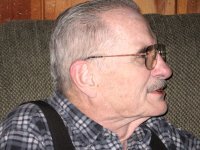
The next morning after a big breakfast with
Cowboy Jim of Canby we were on our way. By the way, Canby was named
after a US General Canby
who was the first general that the Indians killed during the Indian
wars of the west. The ride out of town was another mountain and then
great pedaling on flat country for 50 miles.
About 35 miles south of Klamath I rode up to a
historical marker. I try to read them all along the highways. This
one was of most importance to me. It read:
TULE
LAKE
1942 TO 1946
TULE LAKE WAS ONE OF TEN AMERICAN CONCENTRATION CAMPS ESTABLISHED DURING WORLD WAR 11 TO INCARCERATE 110,000 PERSONS OF JAPANESE ANCESTRY, OF WHOM THE MAJORITY WERE AMERICAN CITIZENS, BEHIND BARBED WIRE AND GUARD TOWERS WITHOUT CHARGE, TRIAL OR ESTABLISHMENT OF GUILT. THESE CAMPS ARE REMINDERS OF HOW RACISM, ECONOMIC AND POLITICAL EXPLOITATION AND EXPEDIENCY CAN UNDERMINE THE CONSTITUTIONAL GUARANTEES OF UNITED STATES CITIZENS AND ALIENS ALIKE. MAY THE INJUSTICES AND HUMILIATION SUFFERED HERE NEVER RECUR.
Thank you for checking in with me. Joe Bowen